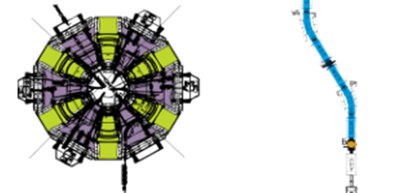
Limits of nuclear existence revealed by mass measurements of titanium isotopes
A group of international researchers from The University of Tokyo, RIKEN, Osaka University, Tokyo City University, Kyoto University, Kyushu University, Rikkyo University, Tokyo University of Science, Tokyo Institute of Technology, The University of Tennessee, University of Notre Dame, and Michigan State University has performed the first direct mass measurements of neutron-rich scandium (Sc), titanium (Ti), and vanadium (V) isotopes, finding that neutrons are firmly bounded in the nucleus of 62Ti that contain 22 protons and 40 neutrons from the analysis of changes in mass.
Atomic nuclei consist of electrically positive protons and electrically neutral neutrons. Ti isotopes are more stable when a nucleus has the same numbers of both protons and neutrons. When neutrons are added to a given nucleus, the binding energy, the energy required to split an atom’s nucleus into protons and neutrons, gradually decreases and the element eventually cannot exist. This is the limit of existence of the nucleus and is called the “nuclear drip line.”
Since the mass of the nucleus is the masses of protons and neutrons and the sum of binding energy of these protons and neutrons in the nucleus, it is possible to know the binding force of neutrons in a nucleus from the "two-neutron separation energy" which can be calculated from the mass difference with an isotope containing two fewer neutrons. The two-neutron separation energy is the energy required to separate two neutrons from a nucleus, indicating how strongly the neutrons bind inside the nucleus.
At the RI Beam Factory (RIBF) at RIKEN, the researchers accelerated 70Zn to about 70% of the velocity of light by the superconducting Ring Cyclotron (SRC) and simultaneously produced various nuclei, including 62Ti, using a superconducting Radioactive Isotope Beam Separator (BigRIPS). Using a set of Chemical Vapor Deposition (CVD) diamond detectors, they measured the time-of-flight (about 2 millionth of a second) between 105-meter beam line of BigRIPS and the Spectroscopy with High-resolution Analyzer of RadioActive Quantum beams (SHARAQ). They reduced noise and increased resolution by reconstructing the beam line from BigRIPS to SHARAQ, and determined the atomic masses of exotic nuclei: 62Ti, 58−60Sc, 60−62Ti, and 62−64V using the time-of-flight magnetic-rigidity (TOF- Bρ) method.
They measured neutron-rich Sc, Ti, and V isotopes around the neutron number 40, showing that the two-neutron separation energies in the vicinity of 62Ti increased compared to neighboring nuclei.
The calculated trends sufficiently matched the experimental values towards N=38, but the experimental results revealed the emergence of a large Jahn-Teller (JT) effect, in the vicinity of 62Ti in comparison with their theoretical predictions, and 62Ti became very stable. The JT effect is a geometric distortion of a non-linear molecular system that reduces its symmetry and energy. As the distortion increases the binding energy, the nucleus is more stable (lower in energy).
In 62Ti, the masses of Ti isotopes near N=40 were affected by the JT effect, developing JT stabilization. It is critical to know how far a large JT stability extends towards more neutron-rich isotopes as observed in 62Ti. Their research results suggest that the extent of this effect may dominate the neutron drip line of other neutron-rich isotopes.
Figure 1
Figure 2
Figure 3
The article, “Mapping of a New Deformation Region around 62Ti,” was published in Nature Communications at DOI: https://journals.aps.org/prl/abstract/10.1103/PhysRevLett.125.122501.
